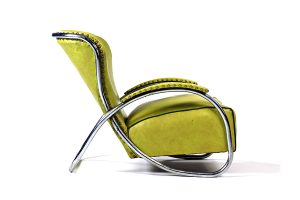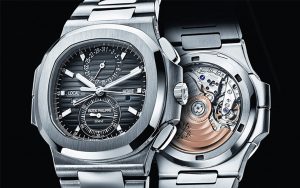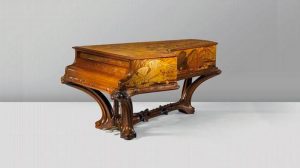The Mini – an iconic car with a design that is recognised around the world.
In production from 1959 to 2000 the Mini (originally named the Austin Seven and Morris Mini-Minor) was in production for 41 years during which 5.3 million cars were sold. Last year (2019) the Mini celebrated its sixtieth birthday.
Sir Alec Issigonis at Austin, Longbridge with one of the first Minis (621 AOK) and a 1965 Morris Mini Minor Deluxe.
Sir Alec Issigonis – Background of the Mini Designer
Issigonis was born in 1906 in Smyrna (now Izmir, Turkey) when it was part of the Ottoman Empire the Issigonis family moved to England in 1922 after the British were exiled from Turkey.
Issigonis’ father was a successful shipbuilding engineer of Greek origin but with a British passport. His mother, Bavaria was said to have been related to Bernd Pischetsrieder, director at BMW and Volkswagen. Sadly, Issigonis’ father did not survive the journey from Smyrna to England.
Issigonis like his father had dreamed of becoming an engineer from a very young age. He studied engineering and excelled at mechanical drawing but struggled with the mathematics, failing the exam three times. After a number of jobs, he worked at Morris in the Engineering Department where he had his first success with the Morris Minor. After the Morris and Austin merged to create the British Motor Corporation (BMC) Issigonis decided to leave the company where he later returned after a discontinued project at Avis.
The Mini Concept
The change in political landscape at the time and the oil crisis of 1956 (and fuel rationing nationally introduced) sparked something inside Issigonis and the challenge to prove himself was set. He tasked himself to design a car with seating space for four, great driving characteristics, affordability and high fuel economy whilst maintaining a lot of interior space and a minimal outer dimension.
The Mini was Born!
By this time Issigonis had the experience and confidence to achieve his ambitious goal of a car for the people. With the success of the Morris Minor in the 40s and his background in motor-racing in the 30 and 40s he and his design team set to work on creating something new. Originally known as XC/9003 project ADO15, the small-town car was one of three models being designed and developed but due to the fuel crisis the production was pushed forward on the smallest of the three (the Mini).
With some urgency, Leonard Lord (1st Baron Lambury and captain of BMC) wanted the car moved to production as quickly as possible. By August 1959 the Morris Mini Minor / Austin Seven (later referred to as just Mini), was launched.
A pair of Mark I adverts for the Austin Seven and Morris Mini-Minor from 1961.
The Mini’s Initial Success
By 1960 the reputation of the Mini had started to gain traction and by 1961 it had so much success Issigonis was promoted to Technical Director of BMC. His contemporaries gave him the nickname ‘The Greek god’ due to the Mini’s overnight popularity. After the initial success production was started on a two-door van, two-door pickup, convertible coupe and Mini Cooper ‘s’ (sport model).
One of the first Minis from 1959 with 10 inch wheels, Mark I & II grille and door hinges. This is the same car Issigonis was photographed with outside the Austin, Longbridge plant.
Original Design
The design and the popularity of the Mini came down to a number of factors. The space saving transverse-engine and gearbox kept the package and footprint of the car compact (this concept has remained standard for small front-wheel drive cars to this day). Although this engine layout was not new it was very uncommon at the time.
The need for the car to be affordable and to save cost wherever possible impacted the design and paved the way to how the Mini looked.
Door Hinges and Welding Seams
The door and boot hinges were mounted externally. This made production of the car easier and cheaper as well as keeping the doors thin by only being single skin. Welding seams clearly visible down the A & C pillar, body and floor pan saved on assembly time and cost.
Sliding windows instead of conventional roll-up
The sliding windows allowed for a single skin door which reduced door bloating within the car’s interior space and increased elbow room. Both the window style and door hinge only appeared on these first two marks due to customer demand for winding windows.
“Smaller” Ten Inch Wheels
The ten inch wheels were more affordable and specialist tyres had to be developed by Dunlop, although a suggestion of eight inch wheels were conceptualised the idea was rejected by Dunlop.
Storage Bins
A bracing bar across the single skin doors was later reworked to create large storage bins on each door. Issigonis later said that he had sized the bins to carry the ingredients of his favourite drink, a dry martini in the correct proportions (one bottle of vermouth and two bottles of Gordon’s Gin).
Similar bins were added later to the rear seats with dual function to support the single skin body and provide more storage. When originally sold the initial Mini had optional wicker baskets to store small items under the rear seats.
Boot Capacity
The fixed rigid parcel shell supported the body and the boot. The boot has hinges at the bottom so the car could be driven with the it open, increasing the storage capacity. The number plate was also hinged so it would still be visible in this circumstance.
Ease and Cost of Production
The production required minimal JIG work, the external seams made it almost self-aligned and allowed the panels to stack on top of one another. This made it easy to ship and accessible for overseas markets and included countries with only basic industrial capabilities.
All of this combined allowed for the shell and body of the car to be incredibly thin, the pillars were small allowing full visibility. The storage buckets, parcel shelf, and under-seat space meant that you could get a lot in the car before the car began to feel cramped.
Issigonis had achieved his brief of creating a small car that seated four that was fun to drive, economical and functional all for the price of £496 (£11,498 in 2020).
Simplistic and Minimal
To save on cost and weight the Mark I and II Mini didn’t come with a radio, heater or anything extra.
Original Design flaws
Although well designed the original Mini did have some drawbacks.
- The steel was prone to rusting
- The original suspension cones were not as Issigonis intended and were a quick substitute due to time limitations
- The radiator was not in the optimal position
- The radiator fan was off the end of the block to cool the radiator causing all the ignition to be placed behind the grille where it was exposed to the rain and weather.
Mini Design changes over the 41-year production
Over the course of its production the Mini has relatively remained unchanged. The Mark III saw enough body change that the car was issued a new factory code from ADO15 to ADO20 which included concealed door hinges and windows that wound (due to customer demand). From April 1974, a heater was standard.
The Mini design is so iconic that in the 90s, Rover Group (heir to BMC), were able to register its design as a trademark in its own right.
Cosmetically on the outside the Mini remained the same after the Mark III. The only changes were based on functionality (flared wheel arches for wider wheels, engine mounting points being moved for the larger 1275cc engine).
The interior became a different environment with the shelf like dash being replaced with a more traditional flat facing concealed dash with glove box. The biggest change for the interior was during the 90’s Rover production, where most of the interior was lifted from one Rover or another.
An Austin Mini Cooper ‘s’ Mark II Mini, 1275cc outputting 76 bhp with Hydrolastic suspension prior to its launch
Racing Pedigree and Cult Following
Not long after its initial release the car gained a cult following. This was initially lead by John Cooper. With a background in designing F1 cars and a friend to Issigonis, Cooper saw the potential for the Mini to be more than a Small-Town car. Issigonis, who was not convinced on the car being used for performance didn’t agree with Cooper, forcing Cooper to appeal directly to BMC management to get permission on the performance model. Both Issigonis and Cooper began working together on modifying the Mini for race!
In 1963 a more powerful Mini Cooper was launched, named the Mini Cooper ‘s’. This model featured a 1071cc (initial ‘s’ models were 848cc with a long stroke to increase it to 997cc) engine with larger 70.61mm bore, larger servo assisted brakes and a longer stroke to increase displacement. A pair of SU carburettors helped increase power from 34 to 55 horsepower. On top of engine performance, the Mini was given a close-ratio gearbox and front disc brakes (uncommon at the time).
These sporty upgrades lead to the Mini winning a number of races including the Monte Carlo Rally in 1964, 1965, 1967. Techincally the Mini won in 1966 but was disqualified controversially due to the headlights being against the rules (the Minis were fitted with non-dipping single filament quartz iodine bulbs in their headlamps, in place of the standard double filament dipping glass bulbs).
To this day the Mini competes in classic racing and the interest and momentum is only growing as time goes on.
The Original Minis Future
Although into its 60s the Mini can still be spotted regularly. With thousands, still on the road it brings warmth, happiness and nostalgia for many. Its original design was practical and accessible leading to its success and cult following.
With so many Minis around and the enthusiasts keen to keep them going the original Mini has evolved. With owners customising and personalising them visually and mechanically. From custom paint colors, unique interiors and other aftermarket features to completely different engines many Minis have become more of a statement and extension of the owner’s personalities and taste.
This expression is far beyond the original functional purpose they were designed for but a resounding statement of how good design allows people to become creative themselves.






